Organisational Behaviour: Leadership and Team Performance Report
VerifiedAdded on 2020/04/15
|12
|2764
|96
Report
AI Summary
This report provides an overview of key concepts in organisational behaviour, focusing on effective cooperation, different types of organizational teams, and the impact of technology on these teams. It delves into the role of virtual team development and networking, team dynamics, and the definitions and differences between groups and teams. The report also examines Tuckman's Team Development Model, Belbin's typology for managing effective teams, and the importance of soft and hard communication. Furthermore, it explores cooperation and competition, the benefits and risks of teamwork, and conflict resolution strategies. The report also applies concepts and philosophies to organizational behaviour, including path-goal theory leadership styles, contemporary barriers to effective behaviour, social capital theory, and contingency theory, providing a comprehensive understanding of organizational dynamics and leadership.
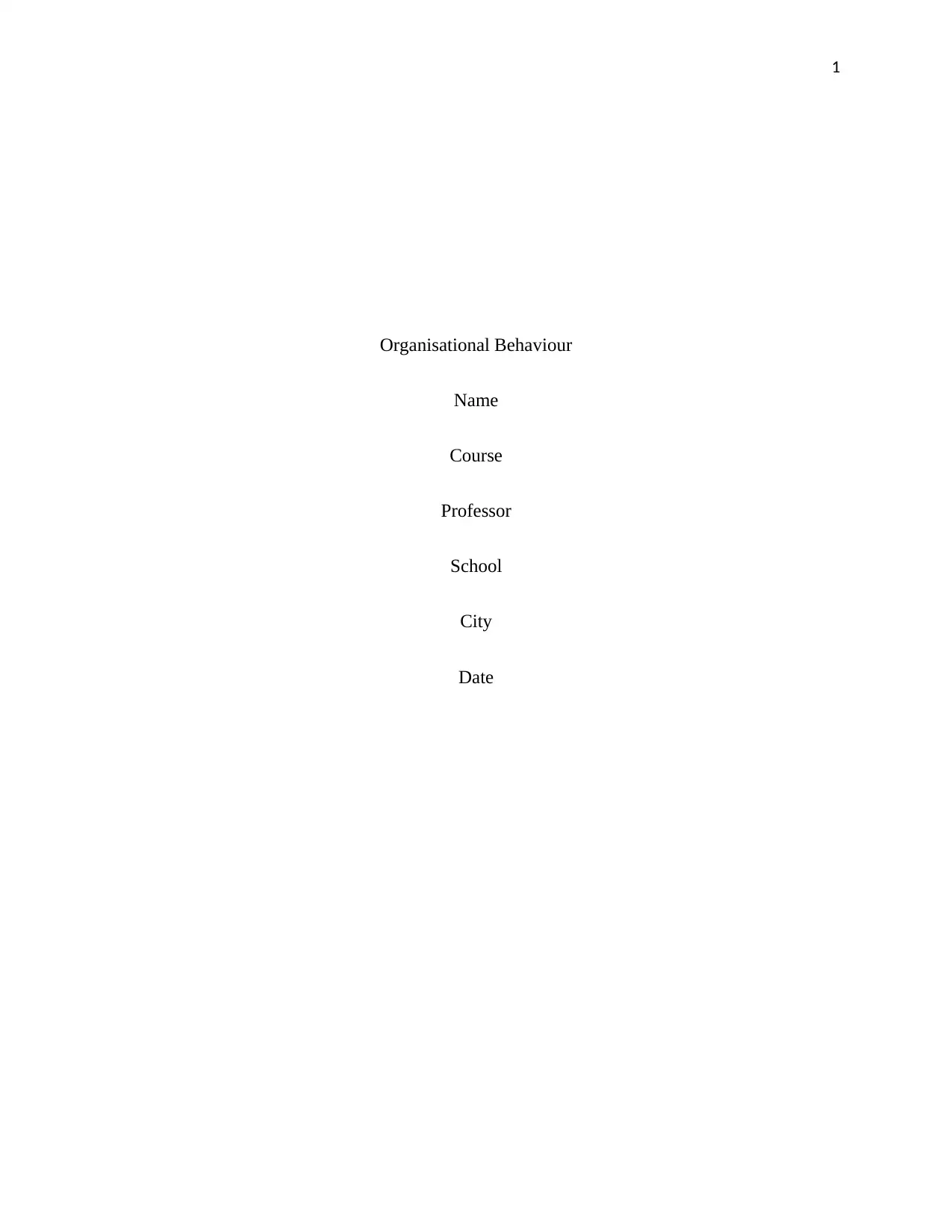
1
Organisational Behaviour
Name
Course
Professor
School
City
Date
Organisational Behaviour
Name
Course
Professor
School
City
Date
Paraphrase This Document
Need a fresh take? Get an instant paraphrase of this document with our AI Paraphraser
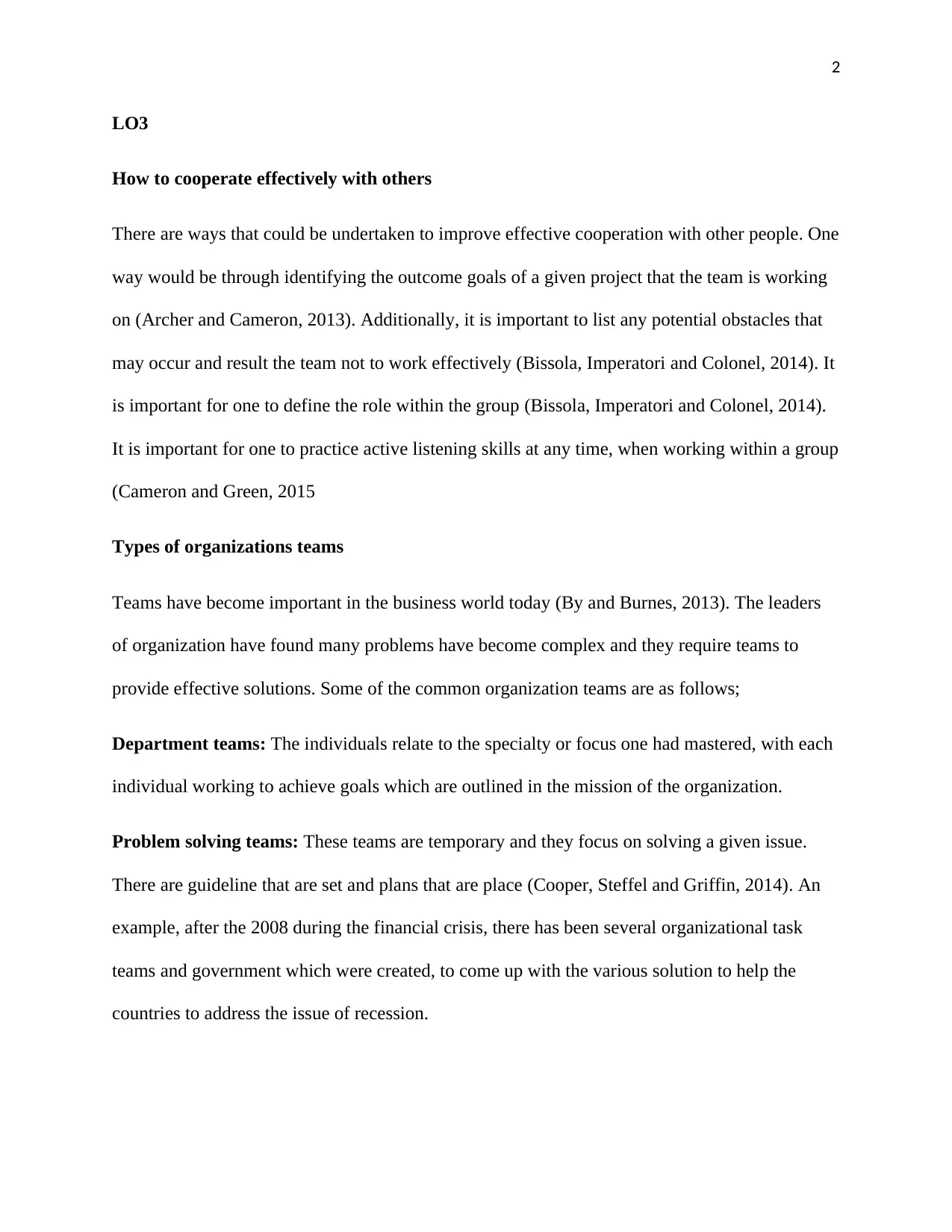
2
LO3
How to cooperate effectively with others
There are ways that could be undertaken to improve effective cooperation with other people. One
way would be through identifying the outcome goals of a given project that the team is working
on (Archer and Cameron, 2013). Additionally, it is important to list any potential obstacles that
may occur and result the team not to work effectively (Bissola, Imperatori and Colonel, 2014). It
is important for one to define the role within the group (Bissola, Imperatori and Colonel, 2014).
It is important for one to practice active listening skills at any time, when working within a group
(Cameron and Green, 2015
Types of organizations teams
Teams have become important in the business world today (By and Burnes, 2013). The leaders
of organization have found many problems have become complex and they require teams to
provide effective solutions. Some of the common organization teams are as follows;
Department teams: The individuals relate to the specialty or focus one had mastered, with each
individual working to achieve goals which are outlined in the mission of the organization.
Problem solving teams: These teams are temporary and they focus on solving a given issue.
There are guideline that are set and plans that are place (Cooper, Steffel and Griffin, 2014). An
example, after the 2008 during the financial crisis, there has been several organizational task
teams and government which were created, to come up with the various solution to help the
countries to address the issue of recession.
LO3
How to cooperate effectively with others
There are ways that could be undertaken to improve effective cooperation with other people. One
way would be through identifying the outcome goals of a given project that the team is working
on (Archer and Cameron, 2013). Additionally, it is important to list any potential obstacles that
may occur and result the team not to work effectively (Bissola, Imperatori and Colonel, 2014). It
is important for one to define the role within the group (Bissola, Imperatori and Colonel, 2014).
It is important for one to practice active listening skills at any time, when working within a group
(Cameron and Green, 2015
Types of organizations teams
Teams have become important in the business world today (By and Burnes, 2013). The leaders
of organization have found many problems have become complex and they require teams to
provide effective solutions. Some of the common organization teams are as follows;
Department teams: The individuals relate to the specialty or focus one had mastered, with each
individual working to achieve goals which are outlined in the mission of the organization.
Problem solving teams: These teams are temporary and they focus on solving a given issue.
There are guideline that are set and plans that are place (Cooper, Steffel and Griffin, 2014). An
example, after the 2008 during the financial crisis, there has been several organizational task
teams and government which were created, to come up with the various solution to help the
countries to address the issue of recession.
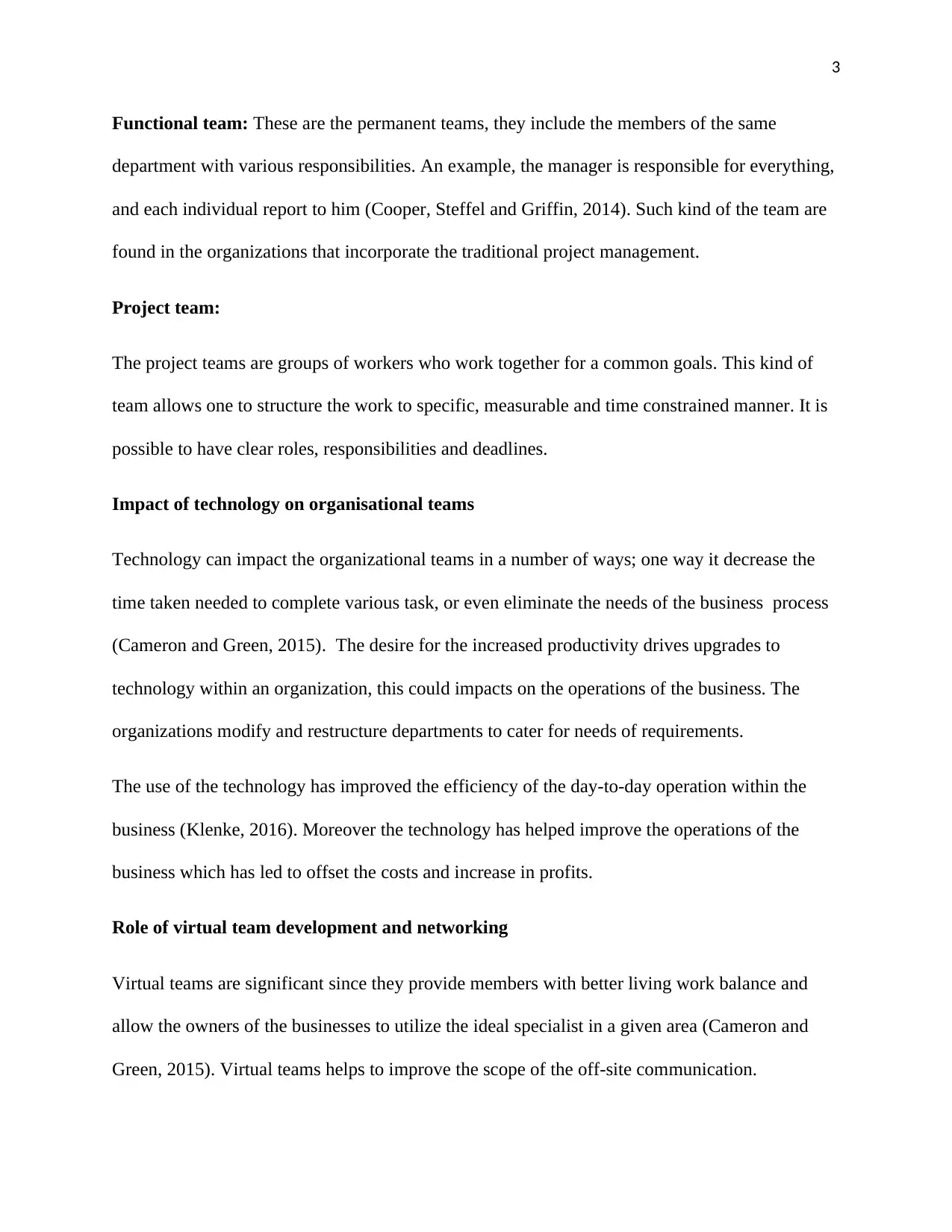
3
Functional team: These are the permanent teams, they include the members of the same
department with various responsibilities. An example, the manager is responsible for everything,
and each individual report to him (Cooper, Steffel and Griffin, 2014). Such kind of the team are
found in the organizations that incorporate the traditional project management.
Project team:
The project teams are groups of workers who work together for a common goals. This kind of
team allows one to structure the work to specific, measurable and time constrained manner. It is
possible to have clear roles, responsibilities and deadlines.
Impact of technology on organisational teams
Technology can impact the organizational teams in a number of ways; one way it decrease the
time taken needed to complete various task, or even eliminate the needs of the business process
(Cameron and Green, 2015). The desire for the increased productivity drives upgrades to
technology within an organization, this could impacts on the operations of the business. The
organizations modify and restructure departments to cater for needs of requirements.
The use of the technology has improved the efficiency of the day-to-day operation within the
business (Klenke, 2016). Moreover the technology has helped improve the operations of the
business which has led to offset the costs and increase in profits.
Role of virtual team development and networking
Virtual teams are significant since they provide members with better living work balance and
allow the owners of the businesses to utilize the ideal specialist in a given area (Cameron and
Green, 2015). Virtual teams helps to improve the scope of the off-site communication.
Functional team: These are the permanent teams, they include the members of the same
department with various responsibilities. An example, the manager is responsible for everything,
and each individual report to him (Cooper, Steffel and Griffin, 2014). Such kind of the team are
found in the organizations that incorporate the traditional project management.
Project team:
The project teams are groups of workers who work together for a common goals. This kind of
team allows one to structure the work to specific, measurable and time constrained manner. It is
possible to have clear roles, responsibilities and deadlines.
Impact of technology on organisational teams
Technology can impact the organizational teams in a number of ways; one way it decrease the
time taken needed to complete various task, or even eliminate the needs of the business process
(Cameron and Green, 2015). The desire for the increased productivity drives upgrades to
technology within an organization, this could impacts on the operations of the business. The
organizations modify and restructure departments to cater for needs of requirements.
The use of the technology has improved the efficiency of the day-to-day operation within the
business (Klenke, 2016). Moreover the technology has helped improve the operations of the
business which has led to offset the costs and increase in profits.
Role of virtual team development and networking
Virtual teams are significant since they provide members with better living work balance and
allow the owners of the businesses to utilize the ideal specialist in a given area (Cameron and
Green, 2015). Virtual teams helps to improve the scope of the off-site communication.
⊘ This is a preview!⊘
Do you want full access?
Subscribe today to unlock all pages.

Trusted by 1+ million students worldwide
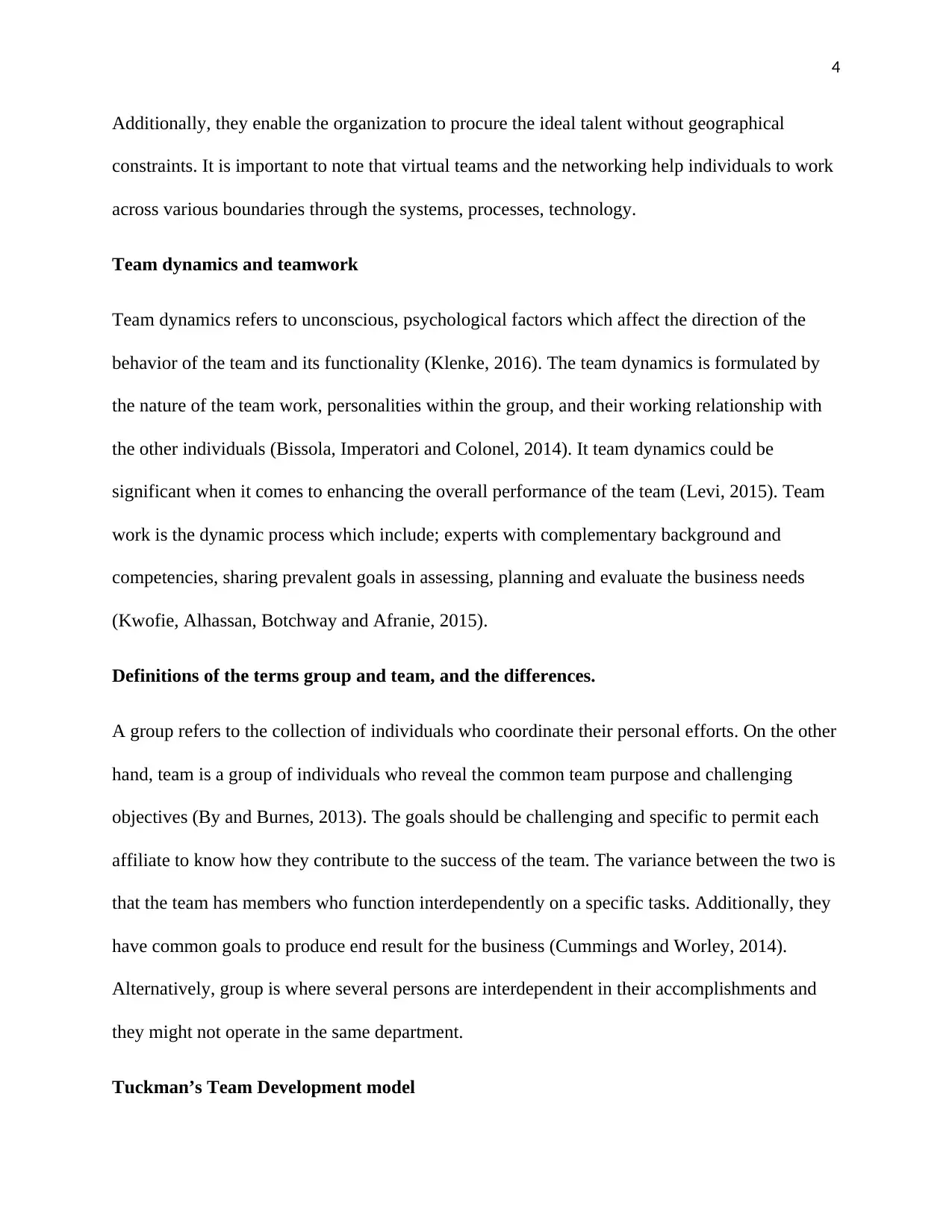
4
Additionally, they enable the organization to procure the ideal talent without geographical
constraints. It is important to note that virtual teams and the networking help individuals to work
across various boundaries through the systems, processes, technology.
Team dynamics and teamwork
Team dynamics refers to unconscious, psychological factors which affect the direction of the
behavior of the team and its functionality (Klenke, 2016). The team dynamics is formulated by
the nature of the team work, personalities within the group, and their working relationship with
the other individuals (Bissola, Imperatori and Colonel, 2014). It team dynamics could be
significant when it comes to enhancing the overall performance of the team (Levi, 2015). Team
work is the dynamic process which include; experts with complementary background and
competencies, sharing prevalent goals in assessing, planning and evaluate the business needs
(Kwofie, Alhassan, Botchway and Afranie, 2015).
Definitions of the terms group and team, and the differences.
A group refers to the collection of individuals who coordinate their personal efforts. On the other
hand, team is a group of individuals who reveal the common team purpose and challenging
objectives (By and Burnes, 2013). The goals should be challenging and specific to permit each
affiliate to know how they contribute to the success of the team. The variance between the two is
that the team has members who function interdependently on a specific tasks. Additionally, they
have common goals to produce end result for the business (Cummings and Worley, 2014).
Alternatively, group is where several persons are interdependent in their accomplishments and
they might not operate in the same department.
Tuckman’s Team Development model
Additionally, they enable the organization to procure the ideal talent without geographical
constraints. It is important to note that virtual teams and the networking help individuals to work
across various boundaries through the systems, processes, technology.
Team dynamics and teamwork
Team dynamics refers to unconscious, psychological factors which affect the direction of the
behavior of the team and its functionality (Klenke, 2016). The team dynamics is formulated by
the nature of the team work, personalities within the group, and their working relationship with
the other individuals (Bissola, Imperatori and Colonel, 2014). It team dynamics could be
significant when it comes to enhancing the overall performance of the team (Levi, 2015). Team
work is the dynamic process which include; experts with complementary background and
competencies, sharing prevalent goals in assessing, planning and evaluate the business needs
(Kwofie, Alhassan, Botchway and Afranie, 2015).
Definitions of the terms group and team, and the differences.
A group refers to the collection of individuals who coordinate their personal efforts. On the other
hand, team is a group of individuals who reveal the common team purpose and challenging
objectives (By and Burnes, 2013). The goals should be challenging and specific to permit each
affiliate to know how they contribute to the success of the team. The variance between the two is
that the team has members who function interdependently on a specific tasks. Additionally, they
have common goals to produce end result for the business (Cummings and Worley, 2014).
Alternatively, group is where several persons are interdependent in their accomplishments and
they might not operate in the same department.
Tuckman’s Team Development model
Paraphrase This Document
Need a fresh take? Get an instant paraphrase of this document with our AI Paraphraser
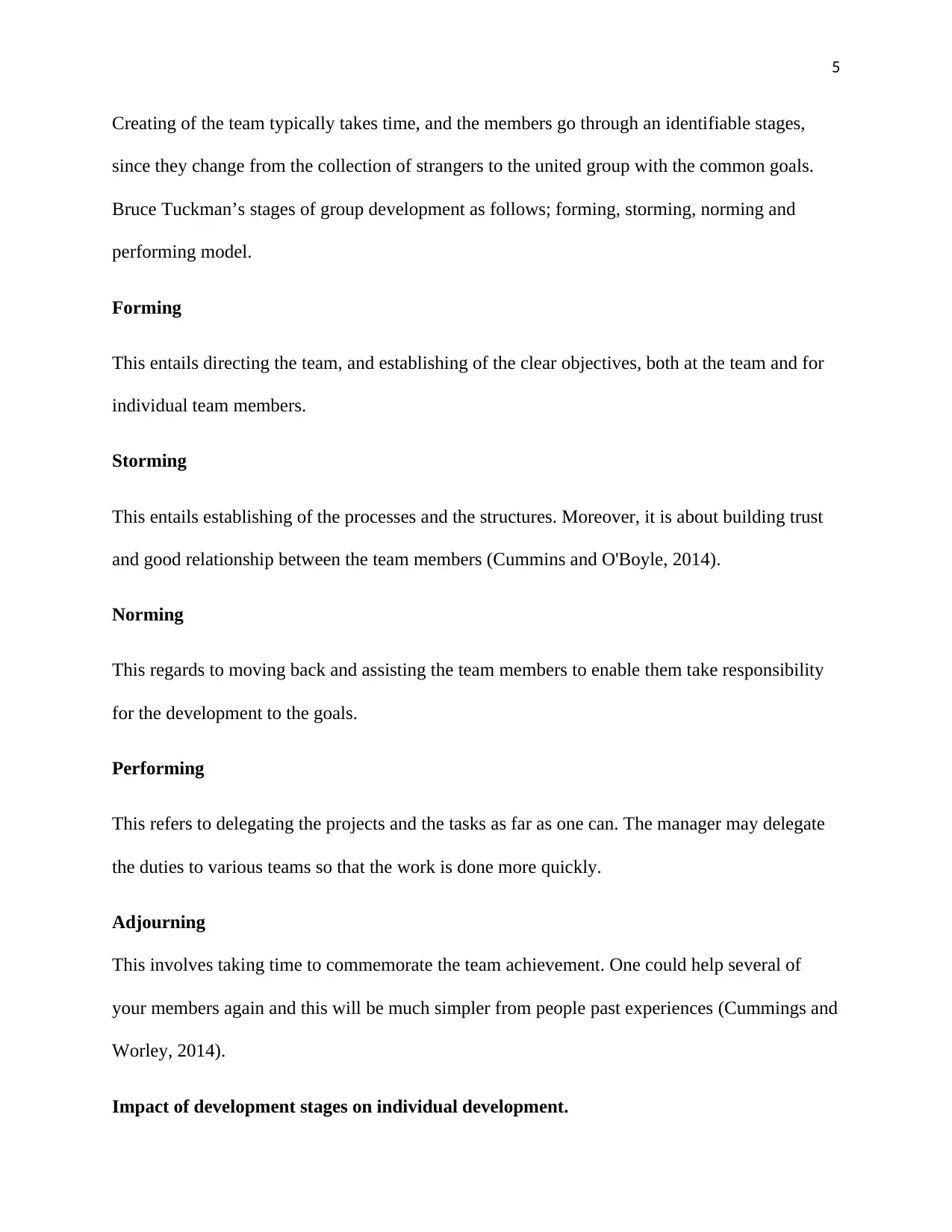
5
Creating of the team typically takes time, and the members go through an identifiable stages,
since they change from the collection of strangers to the united group with the common goals.
Bruce Tuckman’s stages of group development as follows; forming, storming, norming and
performing model.
Forming
This entails directing the team, and establishing of the clear objectives, both at the team and for
individual team members.
Storming
This entails establishing of the processes and the structures. Moreover, it is about building trust
and good relationship between the team members (Cummins and O'Boyle, 2014).
Norming
This regards to moving back and assisting the team members to enable them take responsibility
for the development to the goals.
Performing
This refers to delegating the projects and the tasks as far as one can. The manager may delegate
the duties to various teams so that the work is done more quickly.
Adjourning
This involves taking time to commemorate the team achievement. One could help several of
your members again and this will be much simpler from people past experiences (Cummings and
Worley, 2014).
Impact of development stages on individual development.
Creating of the team typically takes time, and the members go through an identifiable stages,
since they change from the collection of strangers to the united group with the common goals.
Bruce Tuckman’s stages of group development as follows; forming, storming, norming and
performing model.
Forming
This entails directing the team, and establishing of the clear objectives, both at the team and for
individual team members.
Storming
This entails establishing of the processes and the structures. Moreover, it is about building trust
and good relationship between the team members (Cummins and O'Boyle, 2014).
Norming
This regards to moving back and assisting the team members to enable them take responsibility
for the development to the goals.
Performing
This refers to delegating the projects and the tasks as far as one can. The manager may delegate
the duties to various teams so that the work is done more quickly.
Adjourning
This involves taking time to commemorate the team achievement. One could help several of
your members again and this will be much simpler from people past experiences (Cummings and
Worley, 2014).
Impact of development stages on individual development.
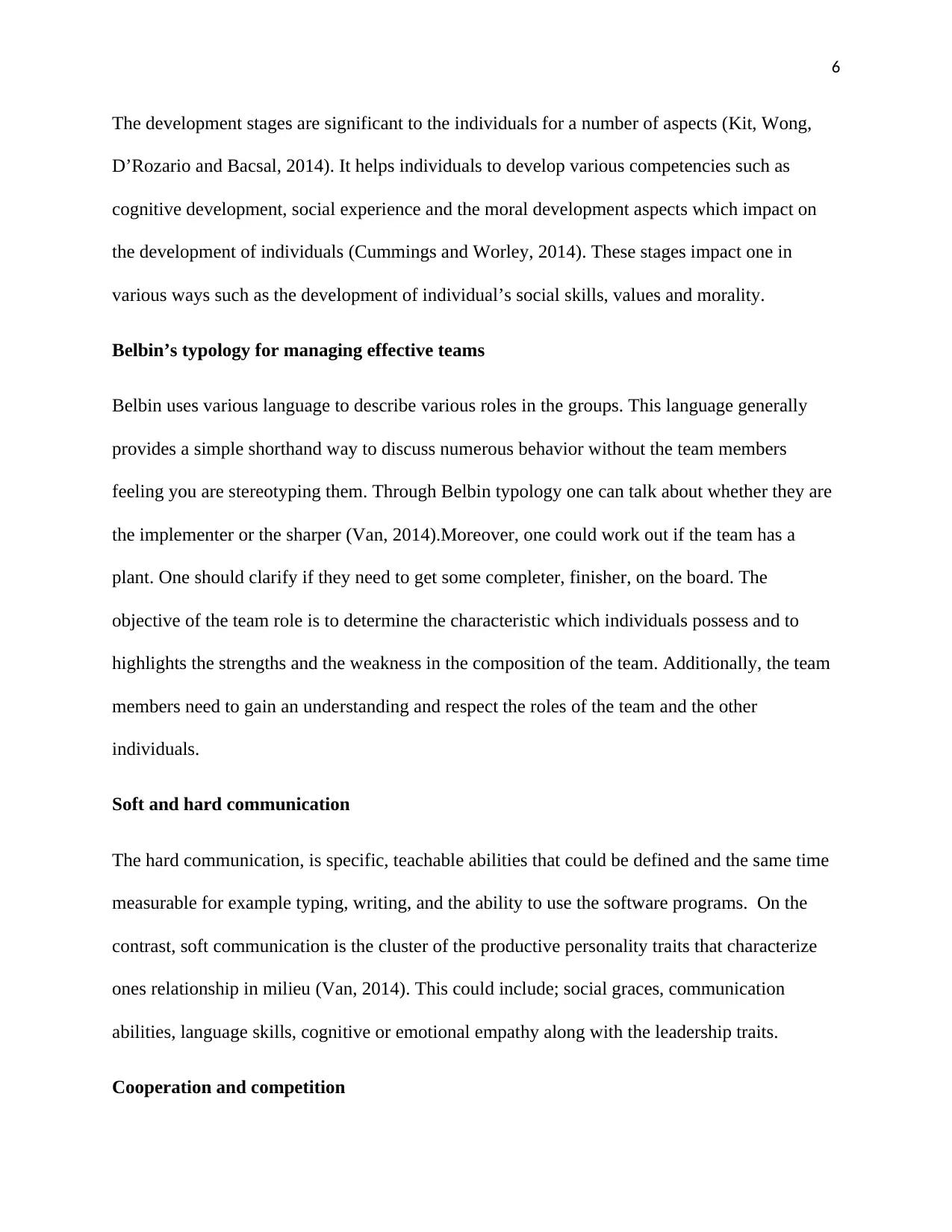
6
The development stages are significant to the individuals for a number of aspects (Kit, Wong,
D’Rozario and Bacsal, 2014). It helps individuals to develop various competencies such as
cognitive development, social experience and the moral development aspects which impact on
the development of individuals (Cummings and Worley, 2014). These stages impact one in
various ways such as the development of individual’s social skills, values and morality.
Belbin’s typology for managing effective teams
Belbin uses various language to describe various roles in the groups. This language generally
provides a simple shorthand way to discuss numerous behavior without the team members
feeling you are stereotyping them. Through Belbin typology one can talk about whether they are
the implementer or the sharper (Van, 2014).Moreover, one could work out if the team has a
plant. One should clarify if they need to get some completer, finisher, on the board. The
objective of the team role is to determine the characteristic which individuals possess and to
highlights the strengths and the weakness in the composition of the team. Additionally, the team
members need to gain an understanding and respect the roles of the team and the other
individuals.
Soft and hard communication
The hard communication, is specific, teachable abilities that could be defined and the same time
measurable for example typing, writing, and the ability to use the software programs. On the
contrast, soft communication is the cluster of the productive personality traits that characterize
ones relationship in milieu (Van, 2014). This could include; social graces, communication
abilities, language skills, cognitive or emotional empathy along with the leadership traits.
Cooperation and competition
The development stages are significant to the individuals for a number of aspects (Kit, Wong,
D’Rozario and Bacsal, 2014). It helps individuals to develop various competencies such as
cognitive development, social experience and the moral development aspects which impact on
the development of individuals (Cummings and Worley, 2014). These stages impact one in
various ways such as the development of individual’s social skills, values and morality.
Belbin’s typology for managing effective teams
Belbin uses various language to describe various roles in the groups. This language generally
provides a simple shorthand way to discuss numerous behavior without the team members
feeling you are stereotyping them. Through Belbin typology one can talk about whether they are
the implementer or the sharper (Van, 2014).Moreover, one could work out if the team has a
plant. One should clarify if they need to get some completer, finisher, on the board. The
objective of the team role is to determine the characteristic which individuals possess and to
highlights the strengths and the weakness in the composition of the team. Additionally, the team
members need to gain an understanding and respect the roles of the team and the other
individuals.
Soft and hard communication
The hard communication, is specific, teachable abilities that could be defined and the same time
measurable for example typing, writing, and the ability to use the software programs. On the
contrast, soft communication is the cluster of the productive personality traits that characterize
ones relationship in milieu (Van, 2014). This could include; social graces, communication
abilities, language skills, cognitive or emotional empathy along with the leadership traits.
Cooperation and competition
⊘ This is a preview!⊘
Do you want full access?
Subscribe today to unlock all pages.

Trusted by 1+ million students worldwide
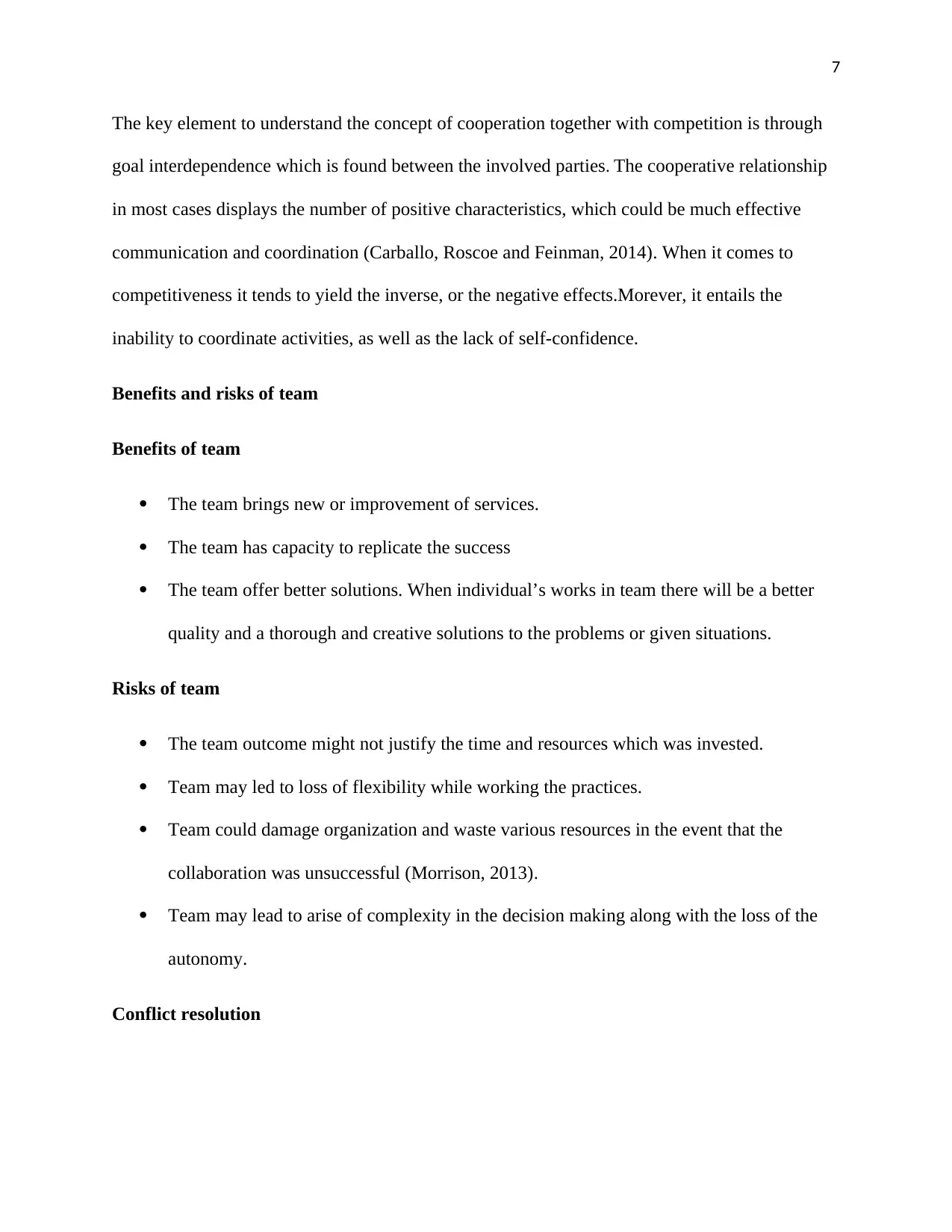
7
The key element to understand the concept of cooperation together with competition is through
goal interdependence which is found between the involved parties. The cooperative relationship
in most cases displays the number of positive characteristics, which could be much effective
communication and coordination (Carballo, Roscoe and Feinman, 2014). When it comes to
competitiveness it tends to yield the inverse, or the negative effects.Morever, it entails the
inability to coordinate activities, as well as the lack of self-confidence.
Benefits and risks of team
Benefits of team
The team brings new or improvement of services.
The team has capacity to replicate the success
The team offer better solutions. When individual’s works in team there will be a better
quality and a thorough and creative solutions to the problems or given situations.
Risks of team
The team outcome might not justify the time and resources which was invested.
Team may led to loss of flexibility while working the practices.
Team could damage organization and waste various resources in the event that the
collaboration was unsuccessful (Morrison, 2013).
Team may lead to arise of complexity in the decision making along with the loss of the
autonomy.
Conflict resolution
The key element to understand the concept of cooperation together with competition is through
goal interdependence which is found between the involved parties. The cooperative relationship
in most cases displays the number of positive characteristics, which could be much effective
communication and coordination (Carballo, Roscoe and Feinman, 2014). When it comes to
competitiveness it tends to yield the inverse, or the negative effects.Morever, it entails the
inability to coordinate activities, as well as the lack of self-confidence.
Benefits and risks of team
Benefits of team
The team brings new or improvement of services.
The team has capacity to replicate the success
The team offer better solutions. When individual’s works in team there will be a better
quality and a thorough and creative solutions to the problems or given situations.
Risks of team
The team outcome might not justify the time and resources which was invested.
Team may led to loss of flexibility while working the practices.
Team could damage organization and waste various resources in the event that the
collaboration was unsuccessful (Morrison, 2013).
Team may lead to arise of complexity in the decision making along with the loss of the
autonomy.
Conflict resolution
Paraphrase This Document
Need a fresh take? Get an instant paraphrase of this document with our AI Paraphraser
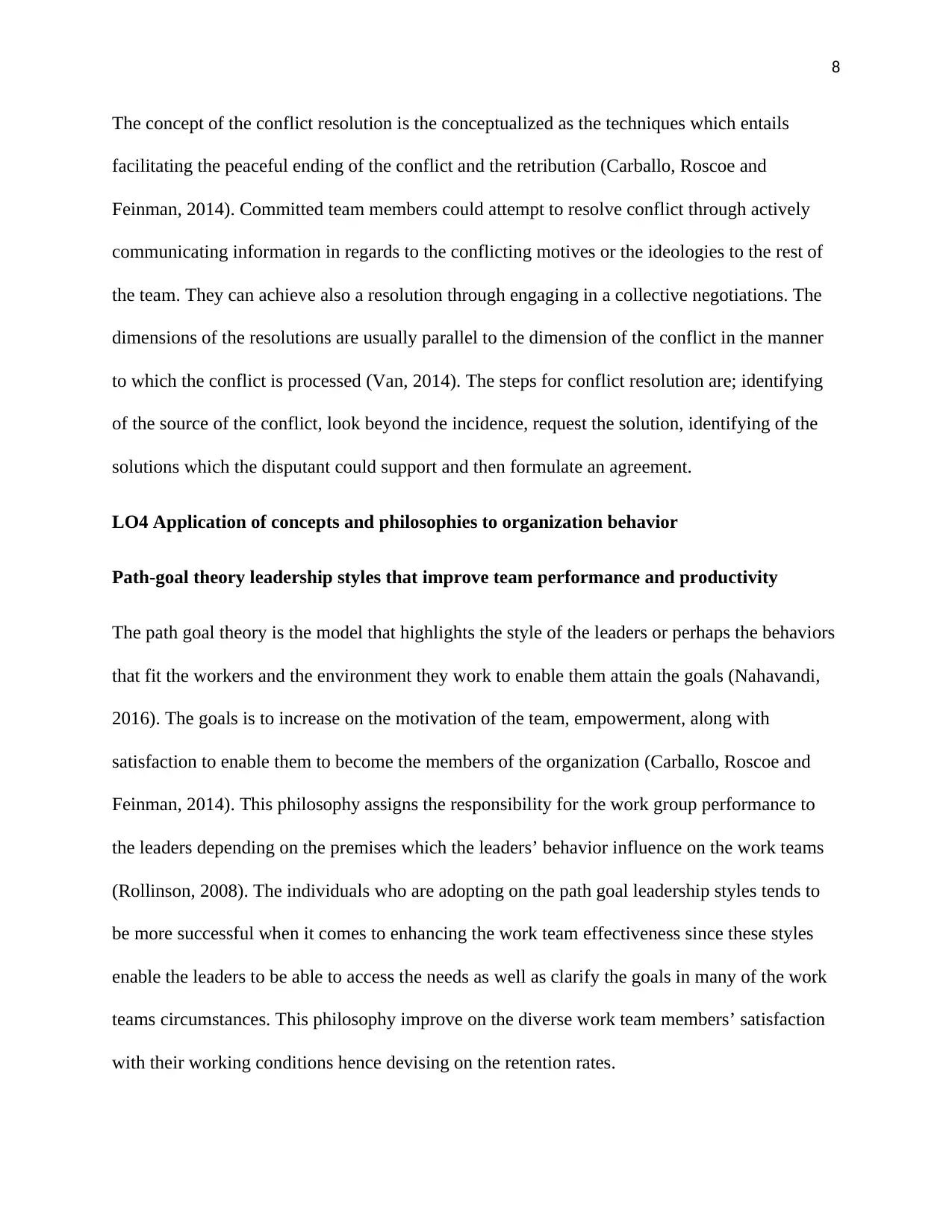
8
The concept of the conflict resolution is the conceptualized as the techniques which entails
facilitating the peaceful ending of the conflict and the retribution (Carballo, Roscoe and
Feinman, 2014). Committed team members could attempt to resolve conflict through actively
communicating information in regards to the conflicting motives or the ideologies to the rest of
the team. They can achieve also a resolution through engaging in a collective negotiations. The
dimensions of the resolutions are usually parallel to the dimension of the conflict in the manner
to which the conflict is processed (Van, 2014). The steps for conflict resolution are; identifying
of the source of the conflict, look beyond the incidence, request the solution, identifying of the
solutions which the disputant could support and then formulate an agreement.
LO4 Application of concepts and philosophies to organization behavior
Path-goal theory leadership styles that improve team performance and productivity
The path goal theory is the model that highlights the style of the leaders or perhaps the behaviors
that fit the workers and the environment they work to enable them attain the goals (Nahavandi,
2016). The goals is to increase on the motivation of the team, empowerment, along with
satisfaction to enable them to become the members of the organization (Carballo, Roscoe and
Feinman, 2014). This philosophy assigns the responsibility for the work group performance to
the leaders depending on the premises which the leaders’ behavior influence on the work teams
(Rollinson, 2008). The individuals who are adopting on the path goal leadership styles tends to
be more successful when it comes to enhancing the work team effectiveness since these styles
enable the leaders to be able to access the needs as well as clarify the goals in many of the work
teams circumstances. This philosophy improve on the diverse work team members’ satisfaction
with their working conditions hence devising on the retention rates.
The concept of the conflict resolution is the conceptualized as the techniques which entails
facilitating the peaceful ending of the conflict and the retribution (Carballo, Roscoe and
Feinman, 2014). Committed team members could attempt to resolve conflict through actively
communicating information in regards to the conflicting motives or the ideologies to the rest of
the team. They can achieve also a resolution through engaging in a collective negotiations. The
dimensions of the resolutions are usually parallel to the dimension of the conflict in the manner
to which the conflict is processed (Van, 2014). The steps for conflict resolution are; identifying
of the source of the conflict, look beyond the incidence, request the solution, identifying of the
solutions which the disputant could support and then formulate an agreement.
LO4 Application of concepts and philosophies to organization behavior
Path-goal theory leadership styles that improve team performance and productivity
The path goal theory is the model that highlights the style of the leaders or perhaps the behaviors
that fit the workers and the environment they work to enable them attain the goals (Nahavandi,
2016). The goals is to increase on the motivation of the team, empowerment, along with
satisfaction to enable them to become the members of the organization (Carballo, Roscoe and
Feinman, 2014). This philosophy assigns the responsibility for the work group performance to
the leaders depending on the premises which the leaders’ behavior influence on the work teams
(Rollinson, 2008). The individuals who are adopting on the path goal leadership styles tends to
be more successful when it comes to enhancing the work team effectiveness since these styles
enable the leaders to be able to access the needs as well as clarify the goals in many of the work
teams circumstances. This philosophy improve on the diverse work team members’ satisfaction
with their working conditions hence devising on the retention rates.
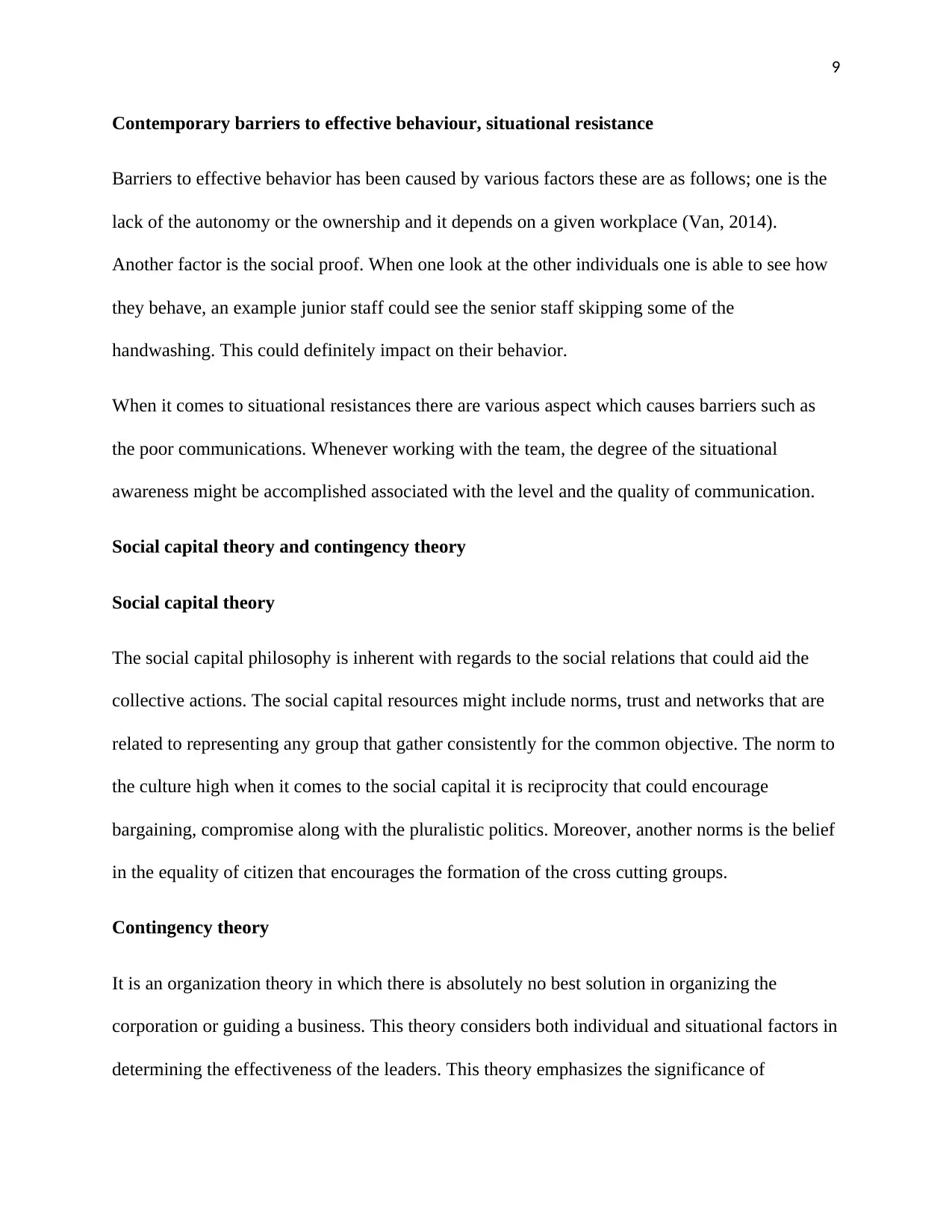
9
Contemporary barriers to effective behaviour, situational resistance
Barriers to effective behavior has been caused by various factors these are as follows; one is the
lack of the autonomy or the ownership and it depends on a given workplace (Van, 2014).
Another factor is the social proof. When one look at the other individuals one is able to see how
they behave, an example junior staff could see the senior staff skipping some of the
handwashing. This could definitely impact on their behavior.
When it comes to situational resistances there are various aspect which causes barriers such as
the poor communications. Whenever working with the team, the degree of the situational
awareness might be accomplished associated with the level and the quality of communication.
Social capital theory and contingency theory
Social capital theory
The social capital philosophy is inherent with regards to the social relations that could aid the
collective actions. The social capital resources might include norms, trust and networks that are
related to representing any group that gather consistently for the common objective. The norm to
the culture high when it comes to the social capital it is reciprocity that could encourage
bargaining, compromise along with the pluralistic politics. Moreover, another norms is the belief
in the equality of citizen that encourages the formation of the cross cutting groups.
Contingency theory
It is an organization theory in which there is absolutely no best solution in organizing the
corporation or guiding a business. This theory considers both individual and situational factors in
determining the effectiveness of the leaders. This theory emphasizes the significance of
Contemporary barriers to effective behaviour, situational resistance
Barriers to effective behavior has been caused by various factors these are as follows; one is the
lack of the autonomy or the ownership and it depends on a given workplace (Van, 2014).
Another factor is the social proof. When one look at the other individuals one is able to see how
they behave, an example junior staff could see the senior staff skipping some of the
handwashing. This could definitely impact on their behavior.
When it comes to situational resistances there are various aspect which causes barriers such as
the poor communications. Whenever working with the team, the degree of the situational
awareness might be accomplished associated with the level and the quality of communication.
Social capital theory and contingency theory
Social capital theory
The social capital philosophy is inherent with regards to the social relations that could aid the
collective actions. The social capital resources might include norms, trust and networks that are
related to representing any group that gather consistently for the common objective. The norm to
the culture high when it comes to the social capital it is reciprocity that could encourage
bargaining, compromise along with the pluralistic politics. Moreover, another norms is the belief
in the equality of citizen that encourages the formation of the cross cutting groups.
Contingency theory
It is an organization theory in which there is absolutely no best solution in organizing the
corporation or guiding a business. This theory considers both individual and situational factors in
determining the effectiveness of the leaders. This theory emphasizes the significance of
⊘ This is a preview!⊘
Do you want full access?
Subscribe today to unlock all pages.

Trusted by 1+ million students worldwide
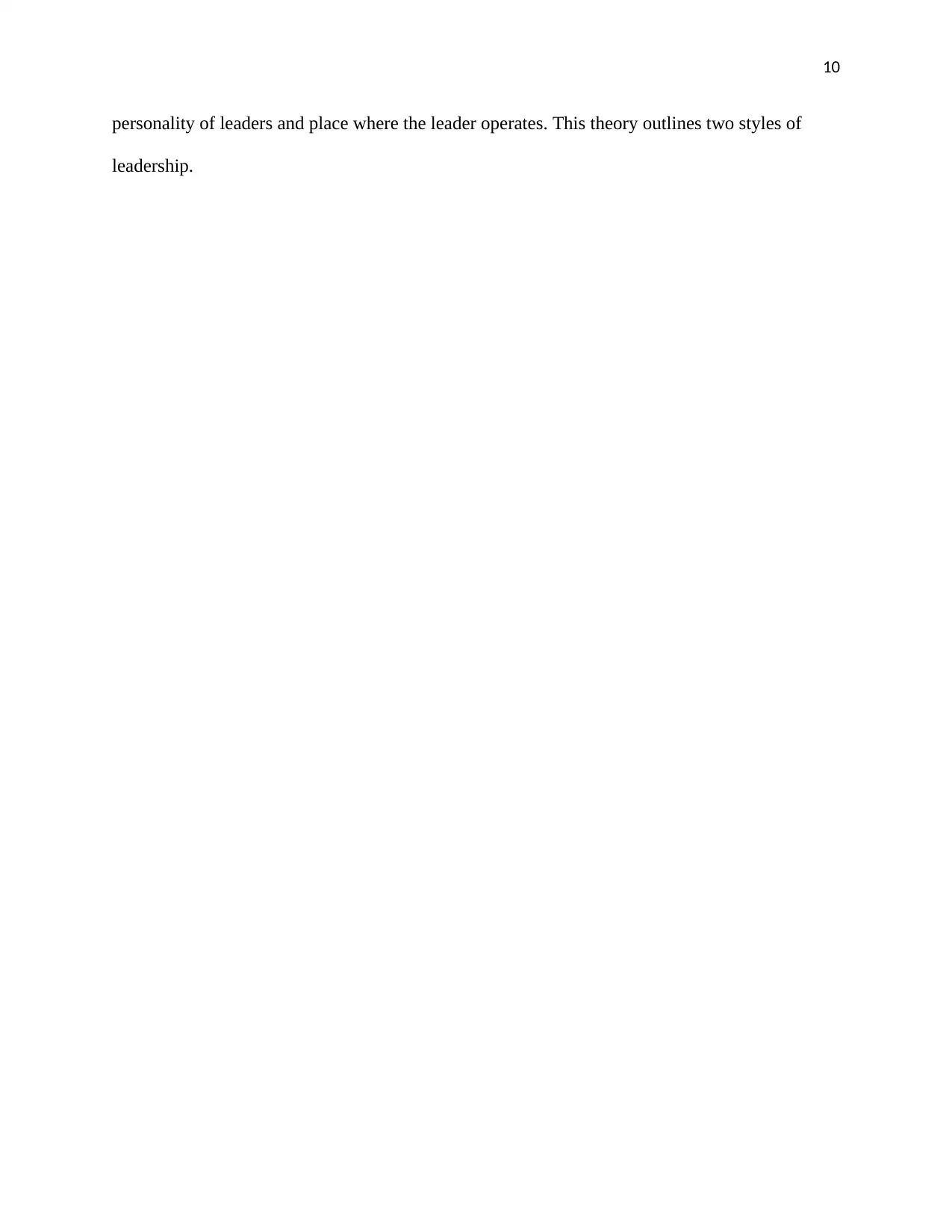
10
personality of leaders and place where the leader operates. This theory outlines two styles of
leadership.
personality of leaders and place where the leader operates. This theory outlines two styles of
leadership.
Paraphrase This Document
Need a fresh take? Get an instant paraphrase of this document with our AI Paraphraser
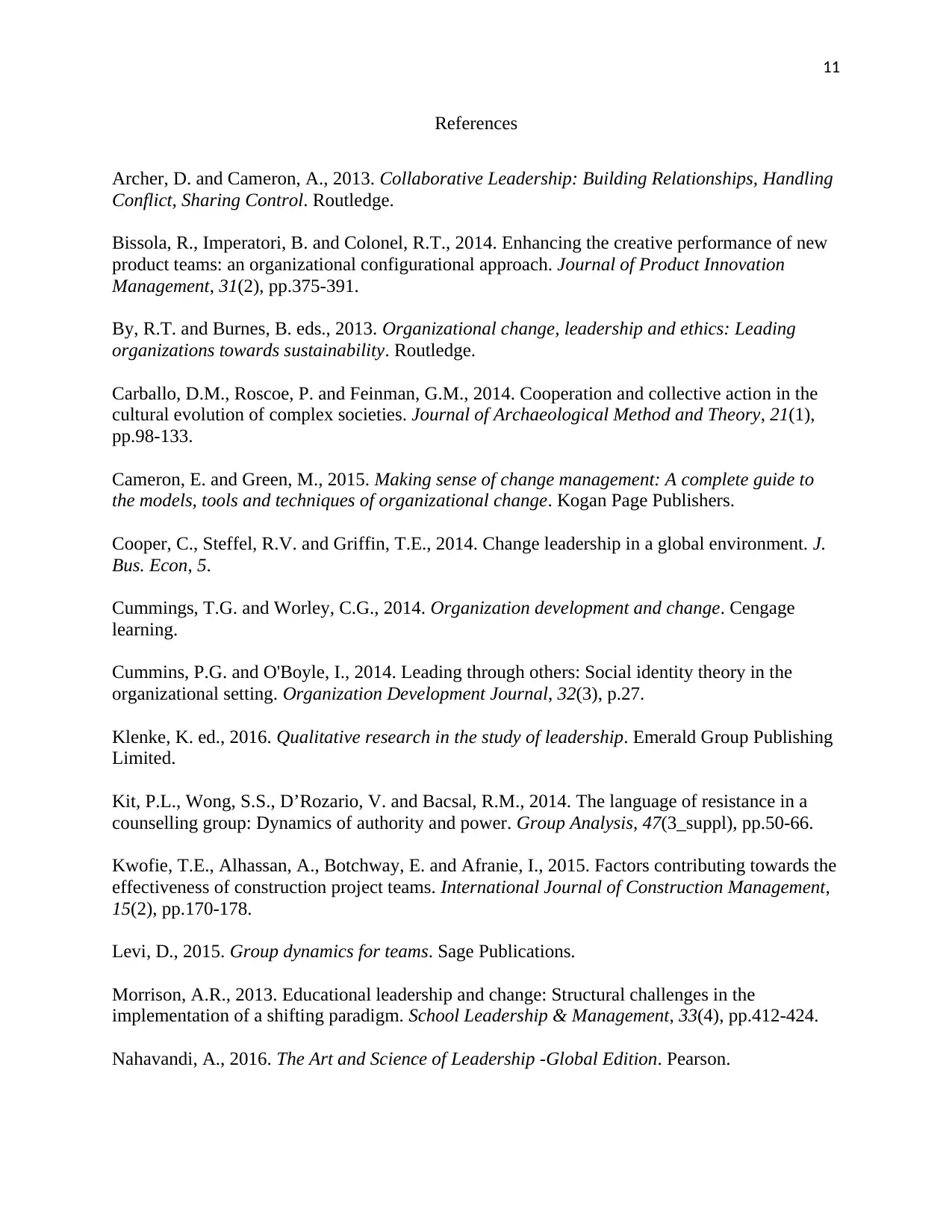
11
References
Archer, D. and Cameron, A., 2013. Collaborative Leadership: Building Relationships, Handling
Conflict, Sharing Control. Routledge.
Bissola, R., Imperatori, B. and Colonel, R.T., 2014. Enhancing the creative performance of new
product teams: an organizational configurational approach. Journal of Product Innovation
Management, 31(2), pp.375-391.
By, R.T. and Burnes, B. eds., 2013. Organizational change, leadership and ethics: Leading
organizations towards sustainability. Routledge.
Carballo, D.M., Roscoe, P. and Feinman, G.M., 2014. Cooperation and collective action in the
cultural evolution of complex societies. Journal of Archaeological Method and Theory, 21(1),
pp.98-133.
Cameron, E. and Green, M., 2015. Making sense of change management: A complete guide to
the models, tools and techniques of organizational change. Kogan Page Publishers.
Cooper, C., Steffel, R.V. and Griffin, T.E., 2014. Change leadership in a global environment. J.
Bus. Econ, 5.
Cummings, T.G. and Worley, C.G., 2014. Organization development and change. Cengage
learning.
Cummins, P.G. and O'Boyle, I., 2014. Leading through others: Social identity theory in the
organizational setting. Organization Development Journal, 32(3), p.27.
Klenke, K. ed., 2016. Qualitative research in the study of leadership. Emerald Group Publishing
Limited.
Kit, P.L., Wong, S.S., D’Rozario, V. and Bacsal, R.M., 2014. The language of resistance in a
counselling group: Dynamics of authority and power. Group Analysis, 47(3_suppl), pp.50-66.
Kwofie, T.E., Alhassan, A., Botchway, E. and Afranie, I., 2015. Factors contributing towards the
effectiveness of construction project teams. International Journal of Construction Management,
15(2), pp.170-178.
Levi, D., 2015. Group dynamics for teams. Sage Publications.
Morrison, A.R., 2013. Educational leadership and change: Structural challenges in the
implementation of a shifting paradigm. School Leadership & Management, 33(4), pp.412-424.
Nahavandi, A., 2016. The Art and Science of Leadership -Global Edition. Pearson.
References
Archer, D. and Cameron, A., 2013. Collaborative Leadership: Building Relationships, Handling
Conflict, Sharing Control. Routledge.
Bissola, R., Imperatori, B. and Colonel, R.T., 2014. Enhancing the creative performance of new
product teams: an organizational configurational approach. Journal of Product Innovation
Management, 31(2), pp.375-391.
By, R.T. and Burnes, B. eds., 2013. Organizational change, leadership and ethics: Leading
organizations towards sustainability. Routledge.
Carballo, D.M., Roscoe, P. and Feinman, G.M., 2014. Cooperation and collective action in the
cultural evolution of complex societies. Journal of Archaeological Method and Theory, 21(1),
pp.98-133.
Cameron, E. and Green, M., 2015. Making sense of change management: A complete guide to
the models, tools and techniques of organizational change. Kogan Page Publishers.
Cooper, C., Steffel, R.V. and Griffin, T.E., 2014. Change leadership in a global environment. J.
Bus. Econ, 5.
Cummings, T.G. and Worley, C.G., 2014. Organization development and change. Cengage
learning.
Cummins, P.G. and O'Boyle, I., 2014. Leading through others: Social identity theory in the
organizational setting. Organization Development Journal, 32(3), p.27.
Klenke, K. ed., 2016. Qualitative research in the study of leadership. Emerald Group Publishing
Limited.
Kit, P.L., Wong, S.S., D’Rozario, V. and Bacsal, R.M., 2014. The language of resistance in a
counselling group: Dynamics of authority and power. Group Analysis, 47(3_suppl), pp.50-66.
Kwofie, T.E., Alhassan, A., Botchway, E. and Afranie, I., 2015. Factors contributing towards the
effectiveness of construction project teams. International Journal of Construction Management,
15(2), pp.170-178.
Levi, D., 2015. Group dynamics for teams. Sage Publications.
Morrison, A.R., 2013. Educational leadership and change: Structural challenges in the
implementation of a shifting paradigm. School Leadership & Management, 33(4), pp.412-424.
Nahavandi, A., 2016. The Art and Science of Leadership -Global Edition. Pearson.
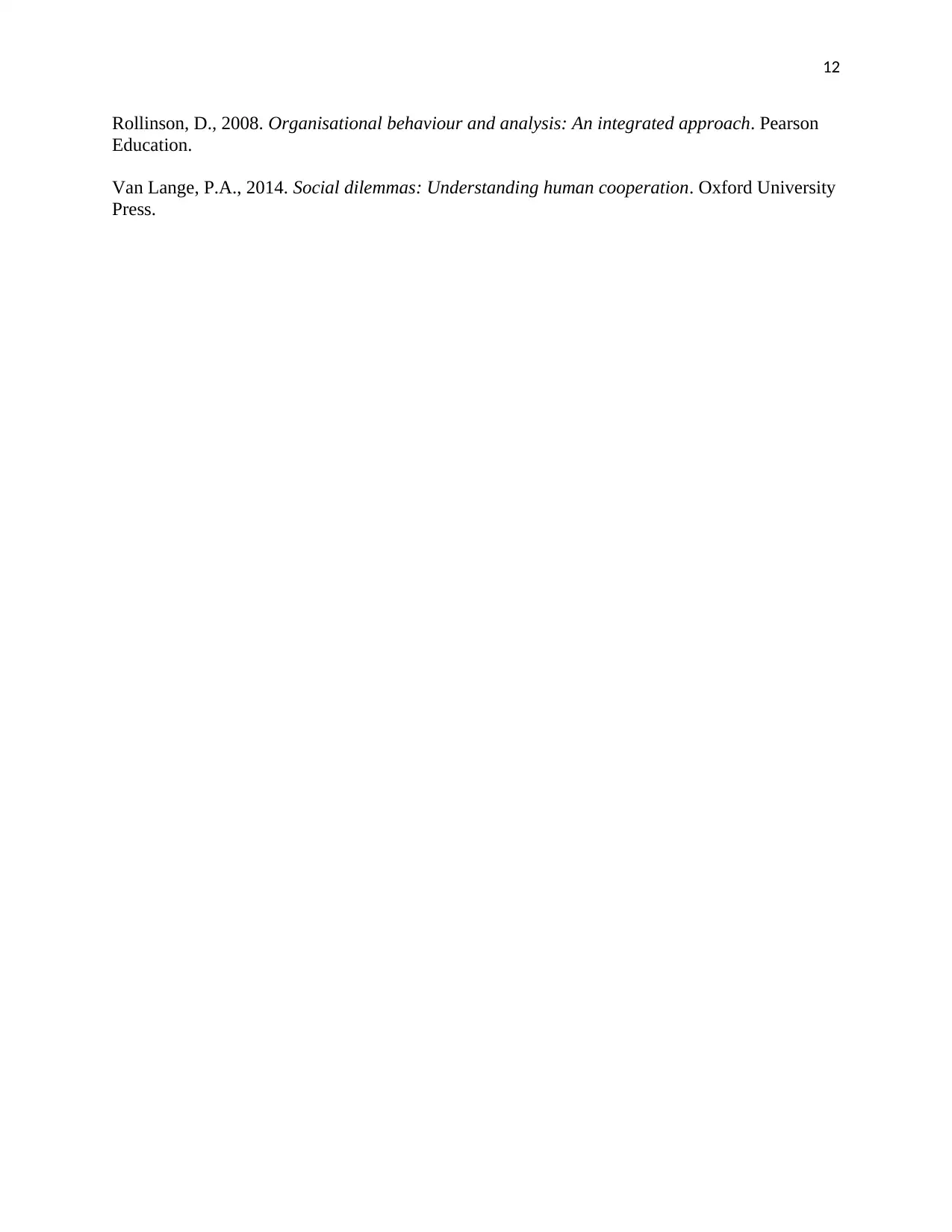
12
Rollinson, D., 2008. Organisational behaviour and analysis: An integrated approach. Pearson
Education.
Van Lange, P.A., 2014. Social dilemmas: Understanding human cooperation. Oxford University
Press.
Rollinson, D., 2008. Organisational behaviour and analysis: An integrated approach. Pearson
Education.
Van Lange, P.A., 2014. Social dilemmas: Understanding human cooperation. Oxford University
Press.
⊘ This is a preview!⊘
Do you want full access?
Subscribe today to unlock all pages.

Trusted by 1+ million students worldwide
1 out of 12
Related Documents
Your All-in-One AI-Powered Toolkit for Academic Success.
+13062052269
info@desklib.com
Available 24*7 on WhatsApp / Email
![[object Object]](/_next/static/media/star-bottom.7253800d.svg)
Unlock your academic potential
Copyright © 2020–2025 A2Z Services. All Rights Reserved. Developed and managed by ZUCOL.





